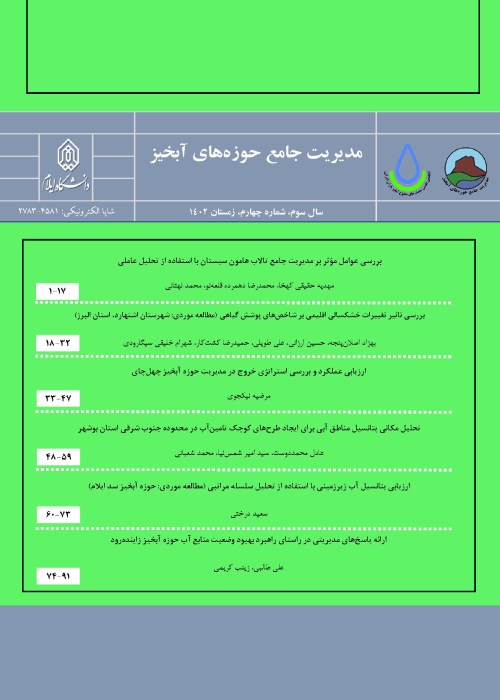Presentation of management responses regarding the strategy of improving the water resources status of Zayandeh Roud Watershed
In arid and semi-arid regions, water is considered as the most important restrictive factor in drinking, industry and agriculture. In this regard, Zayandehroud River is a prominent example of human and environmental concerns in this climate. Due to the large area of the Zayandeh Roud Watershed and the difficulty of developing and implementing a comprehensive participatory management model for the entire watershed, one of the upstream sub-watersheds of the Zayandeh roud Dam was selected for this study based on the Eskandri sub-watershed. This sub-watershed is important because its outlet leads to Zayandeh roud Dam. In addition, this sub-watershed is one of the most important sources of agricultural water supply, drinkable water, and industry in the region and province of Isfahan. Therefore, this study aims to present management responses regarding the strategy of improving the water resources status of the Eskandari sub-watershed with a logical framework approach.
First, the water resources status of the Eskandari sub-watershed was investigated using the Falkenmark index (FI). This index classifies the regions according to the annual renewable per capita volume (RW) for the provision of water resources. Based on the annual renewable per capita volume per person (m3/person), the FI is asfollows: no stress (FI<1700), stress (1000-1700), water low water (500-1000) and absolute deficiency (FI>500). In the following, in order to achieve the goals of integrated watershed management, the logical framework approach was used. Therefore, by identifying the stakeholders and organization of workshops, a problem tree and objectives for the desired strategy was drawn and a logical framework matrix was prepared based on the tree of objectives. In this research, 30 members from stakeholders (random sampling method) were selected as the sample for the resident questionnaire. In other words, the main, sub-goals, achievements, and activities in order to solve the stated problem were extracted from the objectives tree and classified in the framework of the logical framework matrix. Also, the opinion of 28 experts was also considered as a large group decision-making to prioritize items. The expert group consisted of experts from the Departments of Natural Resources and Watershed Management, Environment, Regional Water, and also scientific members of universities of Yazd and Esfahan, and some members of the village council. In the following, for the assessment, prioritization, and feasibility of doing any management response, first, the criteria and indicators for measuring different responses related to the status of the water resources of the Eskandari sub-watershed were determined. Then, the prioritization and selection of responses were done using the questionnaire method and the Friedman's test.
The results of the research showed that the amount of renewable water per person is 637.60 m3. According to the classification provided by Falkenmark, this shows that the Eskandari sub-watershed is in the low water category. In the following, the results of the logical framework showed that the response of the development of optimal allocation plans for water consumption and regulation of water rights has been assigned the highest score according to the indicators and criteria considered. The responses to the strengthening of supervisory and executive mechanisms and modification of laws and regulations for issuance of exploitation licenses and also, preparation and compilation of integrated water resources management plan were the next priorities in terms of status improvement, respectively. In addition, the results of the significance test indicate a significant effect of managerial responses at five percent 0.05 (P=0.00).
This study aimed to provide optimal management responses regarding the strategy of improving the status of water resources based on the expectations and perceptions of the stakeholders. Therefore, due to the ineffectiveness of the solutions in recent years, the implementation of the integrated management program of the Eskandari sub-watershed through the logical framework approach and the participation of all stakeholders is suggested in order for the principled and sustainable exploitation of water resources. Also, reinforcement of regulatory laws is recommended in order to observe water rights and access more equity in exploitation. In addition, in order to reduce water scarcity and improve the condition of watershed, the policies of the water sector should be enforced in a larger framework and with internal and external cooperation.
- حق عضویت دریافتی صرف حمایت از نشریات عضو و نگهداری، تکمیل و توسعه مگیران میشود.
- پرداخت حق اشتراک و دانلود مقالات اجازه بازنشر آن در سایر رسانههای چاپی و دیجیتال را به کاربر نمیدهد.




